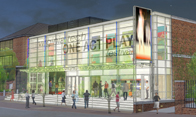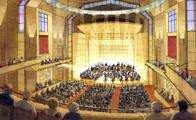In a nutshell, the Arts Initiative has become a major player in the university's latest trek into pioneering collaborations with the goal of strengthening the delivery of its mission's charges.
Creating the creative economy
These days, a stroll down College Avenue--where the Virginia Tech campus meets the heart of downtown Blacksburg--reveals the impact of forward thinking and a creative economy gaining momentum.
Not only are renovations to Henderson Hall underway, preparing it for the university's departments of Music and Theatre Arts, but a nearly completed experimental theatre also looks out onto the same block as the historic Lyric Theatre. In close proximity to the performance venues in Squires Student Center, this new construction signals the gradual emergence of a performing arts district where town and gown have historically gathered.
|
|
|
|
|
|
|
|
|
|
|
|
|
|
|
|
|
|
|
|
|
|
| WHY DEVELOP? |
|
|
Major development during economic downturns is not a foreign notion, even on the Blacksburg campus. During the tenure of Julian A. Burruss (Class of 1898), eighth president of Virginia Agricultural and Mechanical College and Polytechnic Institute (today's Virginia Tech), the Virginia General Assembly cut the college's appropriations by 7.5 percent and salaries by 10 percent in 1932 because of the Great Depression. Created in 1933 to fund large construction projects, the Public Works Administration awarded Virginia Tech a $1,066,000 loan to construct several buildings on campus. Approved in 1934, the loan was later increased, allowing for the construction of Burruss Hall, Eggleston Hall, and the original structure that now houses the Graduate Life Center at Donaldson Brown. The foresight for those buildings laid a solid foundation for the growth of the university and the comprehensive programs that followed.
|
 |
|
WHY CREATIVITY?
|
|
|
As the computer executes more and more of our analytical and sequential tasks, the 21st-century worker will need a skill set of cognitive abilities. As a result, the necessity for creativity in all fields will become a job demand. Author, economist, and university professor Richard Florida and former Department of Labor staffer and business writer Daniel Pink are among the most prominent voices articulating the new creative class/economy concept. Not surprisingly, artists and the arts figure prominently in their forecast. Their research points to jobs that require collaborations between diverse fields and interpretive, contextual, and simultaneous thinking that utilizes synthesis and "big picture" recognition--skills generally linked to artists.
|
 |
|
WHY CULTURE?
|
|
| Creative people choose to live around creative people--and arts, culture, and natural beauty top the list of expectations for the places where they want to live and work. During the Enlightenment in Europe, thinkers and artists gravitated to those communities where their skills were valued. In order for the university to attract the best faculty and students, the curriculum, opportunities, and events must reflect the direction of creative thinkers who seek unique learning and research paths. |
|
|
|
|
|
|
|
|
|
|
|
|
|
|
Central to this ongoing transformation is the Arts Initiative's most significant project, the Center for the Arts, a multifaceted facility incorporating new and renovated space at the intersection of Alumni Mall and Main Street. Now in the design phase, the complex will feature a 1,300-seat, state-of-the-art performance hall, a visual arts gallery, and the Center for Creative Technologies in the Arts. Once realized, the facility will host performances and exhibits and will facilitate the delivery of arts and educational programming, all cultivating a vibrant link between the university and surrounding regions.
"The project has a university-wide focus," says Senior Fellow for Resource Development Minnis Ridenour, whose office oversees the Arts Initiative on behalf of the Office of the President. "There is no question that it can further serve as a magnet for community enhancement and economic development throughout the region. The potential for the center's impact is extraordinary."
The facility's design process is being led by the globally renowned architectural firm, Snøhetta (www.snoarc.no), winner of the international competition to create a museum pavilion at the World Trade Center site in New York City. Other high-profile projects for which the firm has most recently received acclaim include the National Opera House in Oslo, Norway, which appears on the cover of the August 2008 issue of Architectural Record; the Alexandria Library in Egypt; and the Norwegian Embassy in Berlin.
Joining Snøhetta on the project are STV Architects, with offices in Fairfax, Va.; Holder Construction Co., construction manager-at-risk, with offices in Herndon, Va.; Arup, a global engineering and acoustics firm with corporate offices in New York City; and Theatre Projects Consultants, headquartered in Norwalk, Conn.
Because of the involvement of these design specialists, the performance hall will showcase technologically advanced equipment and sophisticated production and sound capabilities. Unlike any other venue in Virginia Tech's geographic area, the hall will have the ability to attract headline performers and shows to the region, as well as provide a first-class performance venue for staging student and community productions.
In similar fashion, the center's proposed arts gallery will incorporate display space for traditional visual art as well as interactive and digital forms and will exhibit both temporarily donated and university-owned artwork. The space will also be suitable for interactive and distance-learning activities and will further facilitate collaborations with the recently opened Taubman Museum of Art in Roanoke, Va., to include exhibitions and educational outreach opportunities.
Finally, plans for ample parking nearby will offer easy access to the center, encouraging even more traffic to the area. The Town of Blacksburg and the entire region will benefit from the economic boost and enhanced quality of life that ultimately accompany a facility of this kind.
Wide-ranging potential plans for the center's use include master classes and artists-in-residence programs, along with expansive opportunities for experiencing and implementing educational, research, and arts-related programs and collaborative projects. By providing a home for such creative endeavors, the Center for the Arts promises to be a significant economic catalyst that will fit well with existing recreational, cultural, and community activities in the New River Valley and in Southwest Virginia.
"There is no question that Virginia Tech's plans for the Center for the Arts will positively impact business and the quality of life in Blacksburg and the surrounding region," notes Blacksburg Town Manager Marc Verniel (urban affairs '92; M.S. urban and regional planning '94). "It's one of the most exciting projects that I've been a part of, and I appreciate being included in the planning process. The greater emphasis on the arts is reason for renewed vitality for the whole community."
Synergy in action: The Center for the Creative Technologies in the Arts
A technological incubator, laboratory, and studio setting for exploring the boundless intersections of art, education, and technology, the Center for Creative Technologies in the Arts (CCTA) embodies Virginia Tech's commitment to enhancing public education across the commonwealth.
Leveraging the university's myriad academic strengths, the CCTA operates across disciplines and in direct collaboration with public school teachers at all levels to develop, test, and deliver innovative arts platforms and learning models, methodologies, and materials that engage our secondary school students--and light up their minds.
Extensive research and the practical experiences of top public school educators have indicated that the holistic integration of the arts with other disciplines prompts a workout for the entire brain, resulting in improved creativity and critical thinking skills, higher retention and motivation, and increased achievement and test levels. In other words, the arts help our students shine.
With an eye toward the future, the CCTA's technology-rich approach, which includes the latest computer design tools, digital art and music technology, and three-dimensional prototyping, will better prepare students for participation in an increasingly creative workforce and technology-based global economy. Moreover, because students clearly benefit from learning models that incorporate the arts and technology, the resulting collaborative products and experiences--many of which will be in digital formats--will be made available to schools across the commonwealth.
Although its renovated space in Shultz Hall won't be completed for several years, the CCTA already has projects underway. Current partnerships among Virginia Tech faculty, School of Education learning specialists, and teachers in six public schools include Virtual Jamestown, an interactive computer simulation of a Native American village that can be the foundation for history, math, and science lessons; and Rapid Prototyping, a hands-on process that bridges the learning similarities between the arts and engineering.
Perhaps now more than ever, partnerships that cross disciplines, critical thinking, and creativity are essential tools for success, and the CCTA is one blueprint for teaching such skills and facilitating such endeavors. When painted in broader brushstrokes, the interdisciplinary collaboration that occurs at the confluence of the arts, education, and technology is a perfect illustration of the university's ongoing efforts to engage our students, energize our communities, and nurture our future.
Portrait of the 21st-century university as an artist
While other research universities are similarly expanding arts programming to provide greater breadth of academic scholarship and opportunity, Virginia Tech has crystal-clear plans for a creative presence that befits a top-tier research university committed to fulfilling the responsibilities of its land-grant mission.
Replete with engineers, artists, scientists, teachers, designers, and visiting scholars working together to discover and disseminate new knowledge and solutions across the spectrum of innovation, life at Virginia Tech will reflect a deep understanding of the ever-evolving skills required for advancement in the 21st century.
A changing global economy; a wired, integrated world; and an expansive, international reach have dictated a re-evaluation of how we approach learning, communication, and work. The role of the arts is taking on a more central and integrated significance in our lives.
And Virginia Tech is at the ready.
To learn more about the Arts Initiative, go to www.artsinitiative.vt.edu.
Juliet Crichton is an editor in University Publications. Jo Evans is director of communications and community relations for the Arts Initiative at Virginia Tech.

